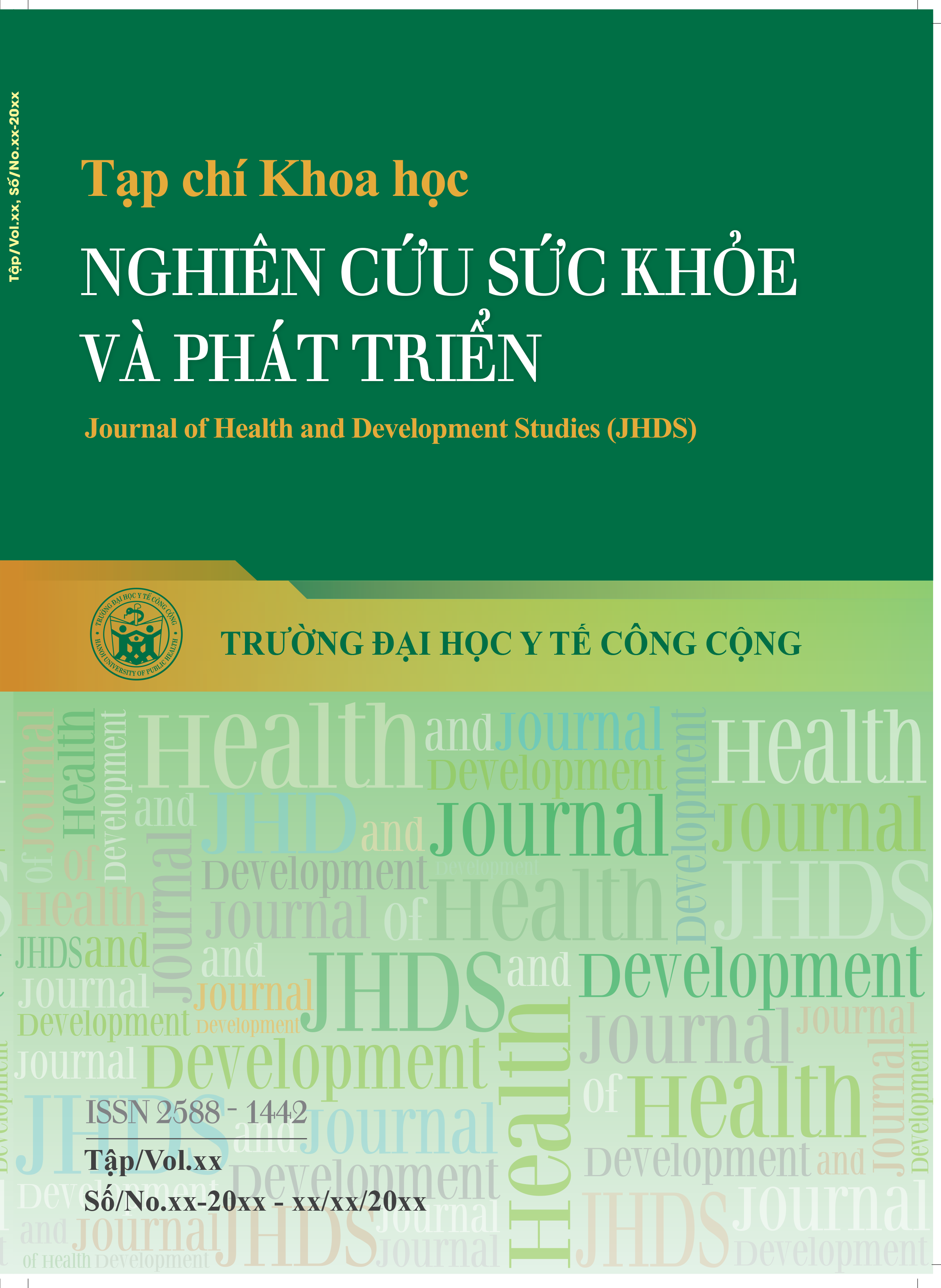Tạp chí
Khoa học Nghiên cứu Sức khỏe và Phát triển
(Journal of Health and Development Studies – JHDS)
Trường Đại học Y tế công cộng
ISSN (Print): 2588-1442
ISSN (Online): XXXX-XXXX
https://jhds.edu.vn
Inpatient experience and influencing factors at Ho Chi Minh city Blood Transfusion and Hematology hospital in 2022
- Mã bài báo : SKPT_23_032
- Ngày xuất bản : 29/02/2024
- Số trang : 92-103
- Tác giả : Nguyen Van Dat
- Lượt xem : ( 416 )
Danh sách tác giả (*)
- Nguyen Van Dat 1 - Ho Chi Minh city Blood Transfusion and Hematology hospital
- Nguyen Phuong Lien 1 - Ho Chi Minh city Blood Transfusion and Hematology hospital
- Pham Quynh Anh 2 - Hanoi University of Public Health
- Nguyen Trung Kien 3 - Hanoi University of Public Health
- Pham Phuong Lien 4 - Viet Nam University of Traditional Medicine
Objective: Policymakers and healthcare managers globally are increasingly focused on collecting Patient Experience (PE) Data to identify information and issues that require improvement for enhancing service quality. For several years, the Ho Chi Minh City Blood Transfusion and Hematology Hospital has prioritized improving patient experience and satisfaction with its services.
Methods: A cross-sectional study incorporating both quantitative and qualitative approaches. Quantitative data were gathered from 250 patients or their main caregivers in six inpatient departments. Quantitative data analysis employed descriptive statistics and non-parametric tests. Qualitative information was obtained through six in-depth interviews with customers (patients and their family members) and seven in-depth interviews with medical staff (hospital leader, 02 clinical department leaders, 02 doctors, and 02 nurses).
Results: The overall Patient Experience (PE) score was 8.5 (median) on a 10-point scale. PED at admission: the waiting time for admission to the inpatient department had the lowest rate of positive experiences (48.8%). Internal Audit on Facilities and Utilities serving patients: the criterion for positive experiences regarding hospital quietness had the lowest rate (65.2%). Internal Audit on the attitude and spirit of service by medical staff, medical examination and treatment activities, and hospital fee payment: all criteria received a fairly high positive evaluation rate of over 86%. Internal accounts before discharge: over 12% of respondents reported difficulties in hospital discharge payment. Factors influencing Internal Revenue Service: Positive factors included the correct application of medical examination and treatment regulations according to the Ministry of Health, administrative procedure reform, new facilities and equipment, training on codes of conduct, and appropriate treatment method selection according to the diagnosis. Negative factors included an incomplete call center for medical examination and treatment, long waiting times for admission to the inpatient department and medical examination, and a lack of methods for patients to pay hospital fees directly in the department or treatment room.
Conclusions: The hospital's overall PED score is 8.5 points. Develop a plan to adjust the process to reduce waiting time for admission from the medical examination department and discharge time; Increase medical human resources to support patient fee collection directly in the treatment department/room.
- DOI : https://doi.org/10.38148/JHDS.0801SKPT23-032
- Chủ đề : Mô hình sức khỏe, ốm đau, bệnh tật, chất lượng cuộc sống
- Loại bài báo : Nghiên cứu gốc
- Chuyên nghành : Chuyên Ngành Y
 Thông tin liên hệ : Nguyen Van Dat
Thông tin liên hệ : Nguyen Van Dat Email : nguyendat.bth@gmail.com
Email : nguyendat.bth@gmail.com Địa chỉ : Ho Chi Minh city Blood Transfusion and Hematology hospital
Địa chỉ : Ho Chi Minh city Blood Transfusion and Hematology hospital
Bài báo liên quan
- Cost – effectiveness analysis of hyaluronic acid injection relative to oral medication for knee osteoarthritis treatment at Nguyen Trai hospital in the period of 2022 – 2023
- Inpatient experience and influencing factors at Ho Chi Minh city Blood Transfusion and Hematology hospital in 2022
- Direct non-medical cost and associated factors in treatment of type 2 diabetes with complications at several hospitals in Ho Chi Minh city
- First-year orientation activities for students in School of preventive medicine and public health- Hanoi Medical University in 2022
- Cost-effectiveness analysis of 2 g of cefazolin compared with 1 g of cefazolin as prophylactic antibiotics in cesarean section at the Mekong Maternity Hospital from 2021 to 2022
- Current mortality situation in Bac Ninh province in the period 2017-2020
- Factors affecting quality of life of hemodialysis patients at Binh Phuoc Hoan My hospital, Vietnam
- Direct treatment cost of patients with psoriatic arthritis disease covered by the social health insurance at the National Hospital of Dermatology and Venereology from 2021 to 2022
- Knowledge, attitude, practice of cervical cancer screening and some factors related to practice in women aged 21 - 65 years old in Dan Quyen commune, Trieu Son district, Thanh Hoa province in 2023
- Knowledge, attitude, and practices of mothers with children under 1-year-old regarding post-vaccination care and related factors in Quang Ngai City, Quang Ngai province, 2023
Bài viết mới nhất
- Một số trang web hữu ích đối với các nhà khoa học
- Dành cho chuyên gia
- Tạp chí Khoa học Nghiên cứu sức khỏe và Phát triển duyệt tối đa 1,0 điểm ngành Y trong Danh mục Tạp chí khoa học được tính điểm của Hội đồng giáo sư Nhà nước
- CHÚC MỪNG NGÀY BÁO CHÍ CÁCH MẠNG VIỆT NAM (21/6)
- GS.TS Hoàng Văn Minh - Hiệu trưởng Nhà trường 'lọt top' nhà khoa học có chỉ số trích dẫn hàng đầu thế giới

 File toàn văn
File toàn văn